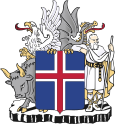Draft:Conservatism in Iceland
| Part of a series on |
| Conservatism in Iceland |
|---|
 |
Conservatism in Iceland has been the dominant ideology of the country's politics since the 20th century, notably under the Independence Party which has dominated Icelandic politics since its inception in 1929. Today it is primarily represented by three parties, namely the liberal conservative Independence Party, the agrarian liberal conservative Progressive Party and the conservative agrarian Centre Party.[1]
History
[edit]Early origins
[edit]The origins of Icelandic conservatism can be traced to the 19th century during Iceland’s struggle for increased autonomy from the Kingdom of Denmark. Early conservative thought was tied to the Icelandic elite, clergy, and educated classes who supported gradual reform and constitutional monarchy rather than radical republicanism. Conservative Icelanders were often aligned with Danish authorities, favoring stability and preserving Icelandic cultural and religious traditions, especially through the Lutheran Church and rural community life.
During this time, nationalist conservatism emerged as a dominant ideology among many Icelanders seeking greater autonomy while maintaining traditional institutions. The rise of Icelandic romantic nationalism, inspired by romantic nationalist ideas from continental Europe, and exemplified by figures such as Jón Sigurðsson, mixed liberal and conservative values in advocating for independence through legal and peaceful means.[2]
20th century
[edit]In the early 20th century, as Iceland gained home rule (1904) and later sovereignty (1918), conservative politics became more organized. The Home Rule Party was founded in 1909, followed by the Conservative Party in 1924, both advocating a pragmatic and gradual approach to independence. In 1929, the Conservative Party merged with the Liberal Party to form the Independence Party.[3]
After the Independence Party was formed, it quickly became the largest party, averaging around 40% of the vote share and consistently winning the popular vote from 1930 until 2009. They combined liberalism and conservatism, supported nationalization of infrastructure, and advocated class collaboration. While mostly in opposition during the 1930s, they embraced economic liberalism, but accepted the welfare state after the war and participated in governments supportive of state intervention and protectionism.
Unlike conservative parties in other Nordic countries, the Icelandic Independence Party has long maintained significant support among working-class voters, which contributed to its dominance throughout the 20th century. It regularly received between 35–45% of the vote and held leading roles in many coalition governments.
While maintaining a commitment to free-market principles, the party also adapted to the Nordic model, accepting public healthcare, education, and various welfare programs. This pragmatic conservatism allowed it to appeal to a broad spectrum of voters across class lines.[4]
21st century
[edit]The 2008 Icelandic financial crisis marked a turning point for the Independence Party. The collapse of Iceland’s major banks led to a public backlash against the political establishment, and the party—having been in power before the crisis—was seen by many as complicit in the deregulation that preceded the collapse. In the 2009 parliamentary elections, the party received just 23.7% of the vote, its worst result since its founding at the time.
Since then, support has fluctuated between 20–25%, though the party remains a central actor in Icelandic politics. It returned to government in 2013 with the Progressive party and has been part of coalition governments with the Left-Greens. In the 2024 parliamentary elections they received just 19.4% of the vote.[5] The party continues to advocate economic liberalism, lower taxes, and national sovereignty, particularly regarding Iceland’s relationship with the European Union, although there is internal debate on the EU question.[6]
Positions
[edit]Domestic
[edit]Icelandic conservatism is characterized by a blend of economic liberalism, strong national sovereignty, and pragmatic governance.
At the heart of Icelandic conservative ideology is support for free-market principles. Icelandic conservatives advocate for lower taxes, deregulation, and fostering private enterprise as essential for economic growth. There is a strong belief in individual responsibility and the importance of economic freedom in driving innovation and prosperity.
While supporting a market-driven economy, Icelandic conservatives also accept elements of the Nordic welfare model. They generally back public healthcare, education, and social welfare systems, seeing them as compatible with a thriving economy.
Socially, Icelandic conservatives tend to hold liberal views on many issues, including abortion and LGBT rights. However, they are generally supportive of maintaining the Church of Iceland as the national church, which remains a topic of ongoing debate in the country.
International
[edit]Conservatives are generally cautious about Iceland’s relationship with the European Union, with many emphasizing the need to protect Iceland’s autonomy in areas such as fisheries, trade, immigration, and foreign policy. While opinions vary on potential EU membership, the consensus has been opposing it.[7]
References
[edit]- ^ Review, Iceland (2017-10-27). "Icelandic Parliamentary Election 2017: Party Overview". Iceland Review. Retrieved 2025-04-04.
- ^ "Hver var Jón Sigurðsson?". Vísindavefurinn (in Icelandic). Retrieved 2025-04-04.
- ^ Political parties of Europe. 1: Albania - Norway, Westport, Conn: Greenwood Pr, 1983, ISBN 978-0-313-23804-8
- ^ Kristjánsson, Svanur (1979). "The Electoral Basis of the Icelandic Independence Party, 1929–1944*". Scandinavian Political Studies. 2 (1): 31–52. doi:10.1111/j.1467-9477.1979.tb00204.x. ISSN 1467-9477.
- ^ Sigurðsson, Grétar Þór; Adam, Darren (2024-11-30). "Iceland Elects: full coverage - RÚV.is". RÚV. Retrieved 2025-04-04.
- ^ Chapman, Michael (2024-04-11). "The Icelandic Financial Crisis". Iceland Review. Retrieved 2025-04-04.
- ^ "Sjálfstæðisflokkurinn – Forsíða" (in Icelandic). Retrieved 2025-04-04.
